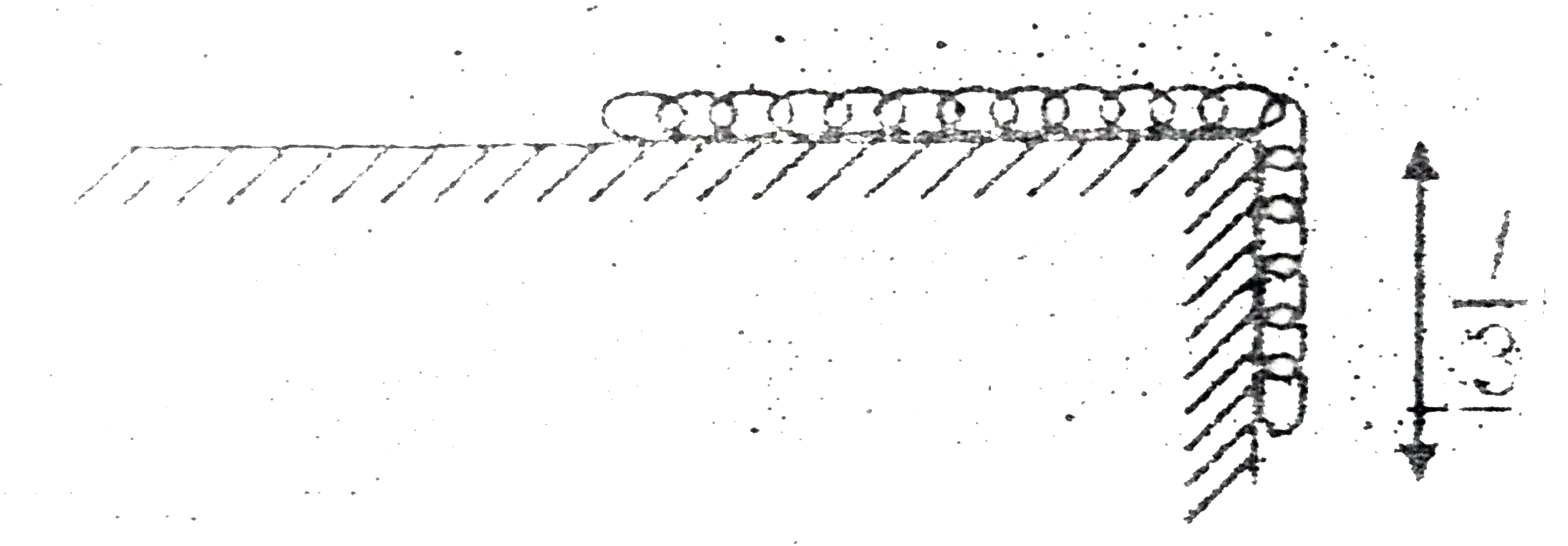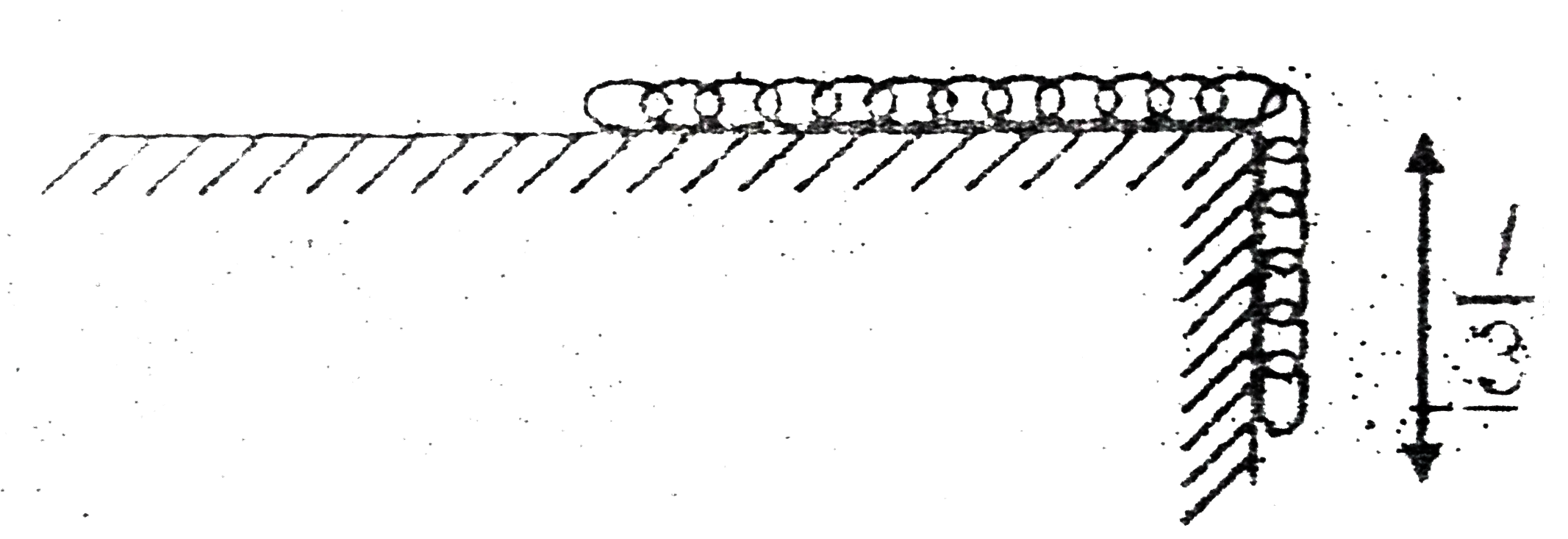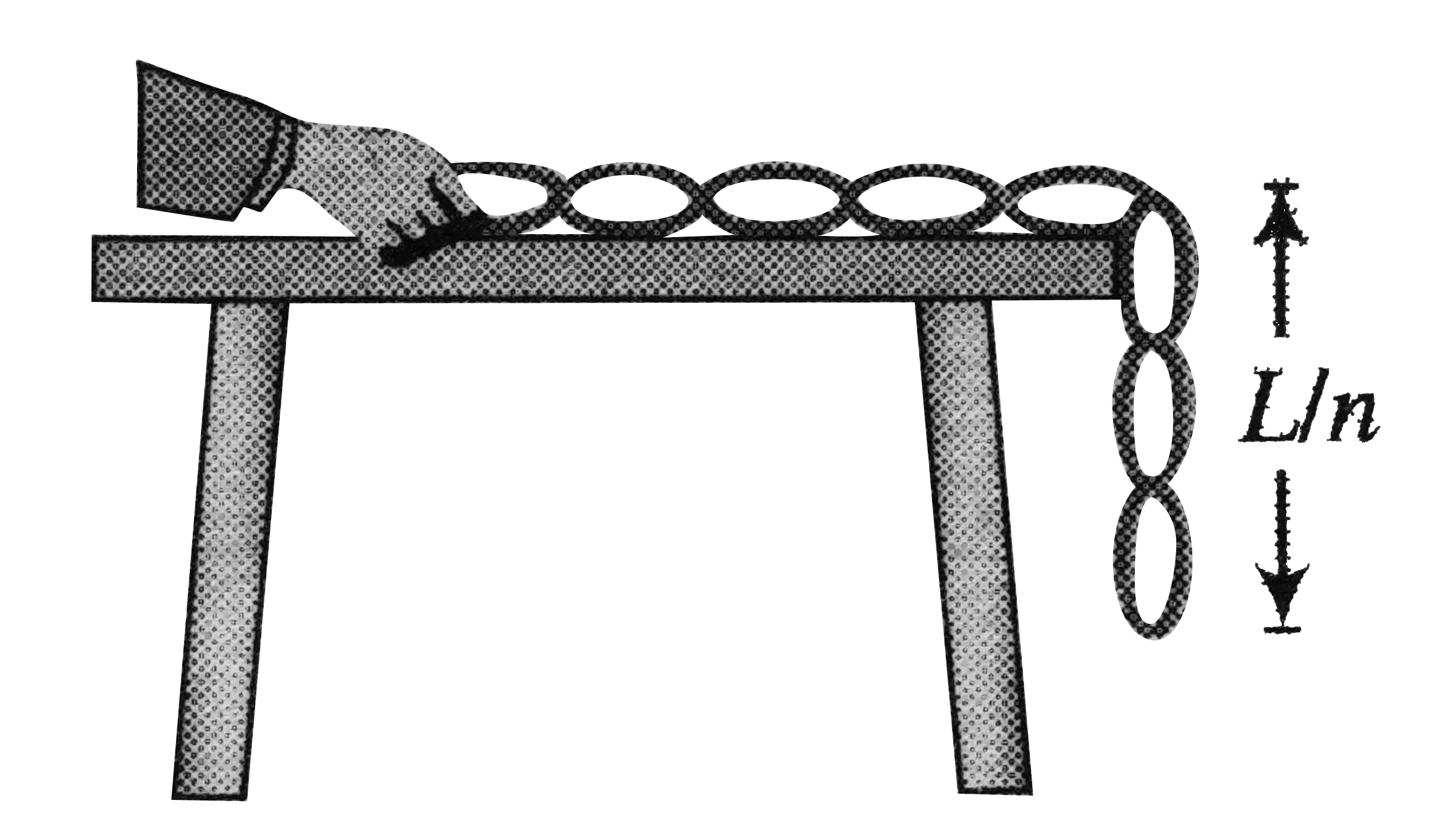A uniform chain of length L and mass M is lying on a smooth table and one-third of its length is hanging vertically down over the edge of the table. If g is the acceleration due to gravity, the work required to pull the hanging part on to the table is
MgL
MgL3
MgL9
MgL18
The correct Answer is:D
To solve the problem of calculating the work required to pull the hanging part of a uniform chain onto the table, we can follow these steps:
Step 1: Understand the problem
We have a uniform chain of length L and mass M. One-third of the chain, which is L3, is hanging vertically down from the edge of the table. We need to find the work done to pull this hanging part back onto the table.
Step 2: Determine the mass per unit length
The mass per unit length of the chain can be calculated as:
Mass per unit length=ML
This means for a length x, the mass mx is given by:
mx=ML⋅x
Step 3: Calculate the force acting on the hanging part
The force acting on the small length dx of the chain that is hanging is the weight of that length, which can be expressed as:
F=mx⋅g=(ML⋅x)⋅g
where g is the acceleration due to gravity.
Step 4: Set up the work done for a small segment
The work done dW to lift a small segment dx of the chain from a height x to the table is given by:
dW=F⋅dx=(ML⋅x⋅g)dx
Step 5: Integrate to find the total work done
To find the total work done to lift the entire hanging part of the chain, we need to integrate from 0 to L3:
W=∫L30(ML⋅x⋅g)dx
Step 6: Perform the integration
Calculating the integral:
W=MgL∫L30xdx
The integral of x is:
∫xdx=x22
Thus,
W=MgL(x22)L30=MgL⋅12(L3)2
Calculating this gives:
W=MgL⋅12⋅L29=MgL18
Final Answer
The work required to pull the hanging part of the chain onto the table is:
W=MgL18
We have a uniform chain of length L and mass M. One-third of the chain, which is L3, is hanging vertically down from the edge of the table. We need to find the work done to pull this hanging part back onto the table.
The mass per unit length of the chain can be calculated as:
Mass per unit length=ML
This means for a length x, the mass mx is given by:
mx=ML⋅x
The force acting on the small length dx of the chain that is hanging is the weight of that length, which can be expressed as:
F=mx⋅g=(ML⋅x)⋅g
where g is the acceleration due to gravity.
The work done dW to lift a small segment dx of the chain from a height x to the table is given by:
dW=F⋅dx=(ML⋅x⋅g)dx
To find the total work done to lift the entire hanging part of the chain, we need to integrate from 0 to L3:
W=∫L30(ML⋅x⋅g)dx
Calculating the integral:
W=MgL∫L30xdx
The integral of x is:
∫xdx=x22
Thus,
W=MgL(x22)L30=MgL⋅12(L3)2
Calculating this gives:
W=MgL⋅12⋅L29=MgL18
The work required to pull the hanging part of the chain onto the table is:
W=MgL18
Topper's Solved these Questions
- WORK , ENERGY AND POWERBOOK - NCERT FINGERTPS ENGLISHCHAPTER - WORK , ENERGY AND POWEREXERCISE - NCERT
18 Videos
- WORK , ENERGY AND POWERBOOK - NCERT FINGERTPS ENGLISHCHAPTER - WORK , ENERGY AND POWEREXERCISE - ASSERTION & REASON
15 Videos
- WAVESBOOK - NCERT FINGERTPS ENGLISHCHAPTER - WAVESEXERCISE - Assertion And Reason
15 Videos
Similar Questions
A uniform chain of length l and mass m is placed on a smooth table with one-fourth of its length hanging over the edge. The work that has to be done to pull the whole chain back onto the table is :
View SolutionA uniform chain of mass m and length l is lying on a horizontal table with one-third of its length hanging over the edge of the table.

What is the speed of the chain, when it just loses contact with the table?
View Solution
Knowledge Check
A uniform chain of length 2m is kept on a table such that a length of 60cm hangs freely from the edge of the table . The total mass of the chain is 4kg What is the work done in pulling the entire the chain the on the table ?
A12.9JB6.3 JC3.6 JD2.0 J
A uniform chain of mass m and length l is lying on a horizontal table with one-third of its length hanging over the edge of the table.

If a gentle push is given to hanging end, it will start moving down. What is the change in gravitational potential energy of the chain, as it just leaves the table?
View SolutionA chain is held on a frictionless table with 1/n th of its length hanging over the edge. If the chain has a length L and a mass M, how much work is required to pull the hanging part back on the table?
View SolutionA uniform chain of mass m and length l is lying on a horizontal table with one-third of its length hanging over the edge of the table.

If the chain is limiting equlibrium, what is the coefficient of friction for the contact between table and chain?
View SolutionA chain of length L and mass M is held on a frictionless table with (1/n)th of its length hanging over the edge. When the chain is released, find the velocity of chain while leaving the table.

View SolutionA chain is held on a frictionless talbe with L/4 hanging over. Knowing total mass of the chain is M and total length is L, the work required to slowly pull hanging part back to the table is :
View SolutionA uniform chain of length L lies on a smooth horizontal table with its length perpendicular to the edge of the table and a small portion of the chain is hanging over the edge. The chain starts sliding due to the weight of the hanging part
View SolutionA uniform chain of mass M and length L is lying on a frictionless table in such a way that its 1/3 parts is hanging vertically down. The work done in pulling the chain up the table is
View Solution
